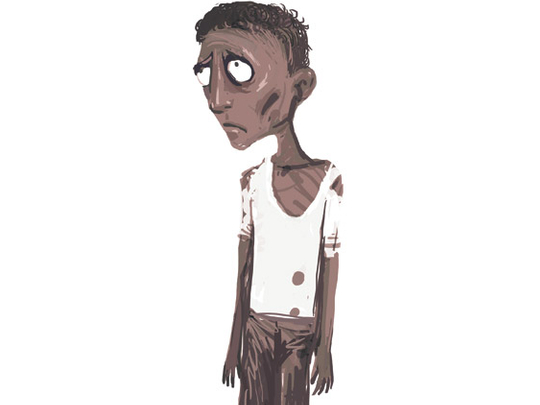
Vishal, the son of a farm labourer in the Indian state of Maharashtra, is almost four. He should weigh around 16 kilograms. But scooping him up from the floor costs his nursery teacher, a frail woman in a faded sari, little effort. She slips Vishal's scrawny legs through two holes cut in the corners of a cloth sack, which she hooks to a weighing scale. The needle stops at just over 10 kilograms — what a healthily plump one-year-old should weigh.
That his teacher does not look perturbed is unsurprising. Nearly half of India's small children are malnourished: one of the highest rates of underweight children in the world, higher than most countries in sub-Saharan Africa. More than one-third of the world's 150 million malnourished under-fives live in India.
Vishal's rural village is not especially impoverished; 120 kilometres from Mumbai, India's financial centre, it offers factory-work as well as the farm labour most country people do. But the battered register in Vishal's nursery, a government-run centre known as an anganwadi (literally, courtyard), shows that close to half the children are malnourished, a handful chronically so.
"It's always been this way," says Sunanda, the anganwadi teacher, who has weighed the children in her care every month for 25 years. "Nothing has changed."
Almost as shocking as the prevalence of malnutrition in India is the country's failure to reduce it much, despite rapid growth. Since 1991, India's gross domestic product (GDP) has more than doubled, while malnutrition has decreased by only a few percentage points.
Meanwhile, the chasm between lucky and unlucky Indian children is growing: under fives in rural areas are more likely to be underweight than urban children, low-caste children than higher-caste children, girls rather than boys. And the disparities are growing. India seems certain to miss one of its key Millennium Development Goals: halving malnutrition by 2015.
Malnutrition places a heavy burden on India. It is linked to half of all child deaths and nearly a quarter of cases of disease. Malnourished children tend not to reach their potential, physically or mentally, and they do worse at school than they otherwise would.
This has a direct impact on productivity: the World Bank reckons that in low-income Asian countries physical impairments caused by malnutrition knock 3 per cent off GDP. Why, then, has India done so little to reduce it?
There are many reasons. Most fundamentally, poor parents find it hard to buy enough food; but that is by no means the only factor. Impoverished and rural families are also less likely to go to a doctor when their children fall sick, which they do a lot, thanks to dirty water and poor hygiene.
Educating parents about how to feed their children should be more quickly achieved than ensuring that the 410 million Indians who live below the UN's estimated poverty line of $1.25 (Dh4.58) a day have enough to eat.
The government, however, has largely failed in both areas. Two big, expensive schemes designed to reduce malnutrition — a public distribution system (PDS) that provides subsidised food to the poor and a vast midday-meal scheme, to which 120 million schoolchildren are signed up — are hampered by inefficiency and corruption.
But the government's main effort to tackle child malnutrition, the Integrated Childhood Development Service (ICDS), has failed for rather different reasons.
Showing promise
The ICDS, launched in 1975, is the world's biggest early-childhood scheme. It provides, in theory, an anganwadi centre with one teacher and an assistant for every 1,000 people. Each centre is responsible for providing nutritional care to pregnant women and all children up to six, the age at which Indian children start school.
Anganwadi centres also provide daily pre-school child care and education, as well as keeping a dozen-odd registers recording everything from children's weights to financial accounts. Overburdened by this long list of responsibilities, anganwadi workers have tended to focus on the group they see every day: children over the age of two whose mothers take advantage of free child care and daily meals offered by the centres.
While these meals — supposedly providing each child with an extra 500 calories a day — are certainly beneficial, they do not replace the nutritional guidance the parents of young children need. More seriously, this emphasis on older children means that the under-twos and pregnant women barely get a turn.
More than half the women of childbearing age in India are anaemic—a condition that can be much improved by fortifying food — and 30 per cent of Indian children are born underweight. In healthy infants, this could be corrected with six months of exclusive breastfeeding. But especially in rural India, where women often go back to the fields mere days after giving birth, babies' diets are often supplemented with cow's milk and water, which exposes them to infection.
The two meals served at Vishal's anganwadi — a plate of puffed rice dotted with a few nuts and a serving of sprouted moong dal — seem unlikely to give him 500 calories.
Vandana Krishna, the state's secretary of Women and Child Development, says the funding gap could be solved by giving village panchayats, or local governments, a special fund to make loans to anganwadis.
Fortifying the food handed out by the PDS would be an economical and effective way to lower rates of anaemia and increase nutrition. So far, India has resisted that idea. But most experts agree that the country will make a serious dent in child malnutrition only when it focuses on pregnant women and the very young, perhaps by providing an additional worker in each anganwadi centre to make home visits.
"India has missed its big window of opportunity by not giving priority to mothers and the under-threes," says Victor Aguayo, chief of Unicef's nutrition programme in India. "It cannot afford to do so any longer."










